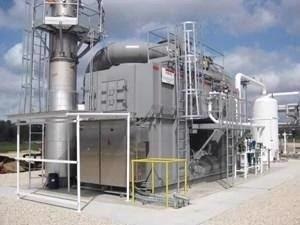Increases in natural gas production, plastic manufacturing and chemical processing leaves refineries with unique air pollution control challenges and opportunities.
This has, in turn, prompted government agencies to introduce appropriate air-pollution control regulations to control the tail gases produced in refining which are not required for futher processing.
Adherence to environmental regulations can be expensive, and a balance must be struck between protecting air, water and land while meeting the demand of consumers. This is especially important for companies operating on tight budgets and margins.

Image Credit: Anguil Environmental Systems
Oil, gas, chemical, and petrochemical producers are frequently required to meet regulations in place to prevent untreated air pollutants from entering the atmosphere. In the United States this is often a Title V permit from the Environmental Protection Agency (EPA).
These volatile organic compounds (VOCs) and hazardous air pollutants (HAPs) harm trees and plants, and they are also known to cause respiratory ailments, birth defects, nervous system damage, heart conditions and cancer in humans.
The Clean Air Act in the US requires companies with the capacity to emit over 10 tons of a single VOC or HAP during a one-year period – or 25 tons of different compounds – to utilize either maximum achievable control technology (MACT) or an appropriate pollution control device.
A significant number of pollution control devices employed in the abatement of these emissions also emit large amounts of nitrous oxides (NOX) and carbon dioxide (CO2).
As compulsory greenhouse gas (GHG) reporting is likely to be introduced, this could lead to increased capital and operating costs as processors pay for carbon emissions generated by their pollution control systems to maintain regulatory compliance.
Midstream’s Abatement History
A range of processes and production techniques employed by midstream companies are considered to be regulated emission sources, with more of these set to be regulated over the coming months and years.
Strict legislation is in force around a range of technologies ranging from amine systems to stationary combustion engines.
Amine tail-gas treatment is a major area of concern. Amine systems are a frequently used, critical component in many natural gas-processing facilities, with these systems key to the removal of CO2, acid gases and hydrogen sulfide (H2S) from the wellhead.
The gas is passed through a column with amine liquid flowing in the opposite direction. This strips acids from the natural gas, absorbing these into the liquid. Following this process, the amine is sent to be regenerated and the natural gas is sent for further processing.
Before the amine solution can be reused, the regeneration process must remove acid gas from the amine solution. This process generates tail gas, however, which must also be treated.
Midstream companies often leverage abatement technologies like flares and vapor combustors as well as thermal and catalytic oxidizers. They are commonly employed in a wide range of applications where there is a need for VOC, HAP and odor abatement.
These technologies destroy potentially dangerous emissions via high-temperature combustion to ensure the destruction of emissions.
These devices are used in applications such as amine tail-gas treatment, liquefied natural gas (LNG) processes and nitrogen rejection units.
Temperatures in these systems are typically maintained between 1400 °F and 1800 °F to ensure that any H2S is converted to sulfur dioxides (SO2 and SO3) and hydrocarbons are converted to CO2 and water vapor.
The legacy technologies are relatively reliable when designed and used appropriately, but their effectiveness and efficiency have been a source of debate in recent years.
For example, flares often require water to be injected into the device to reduce visible black smoke, significantly lowering destruction efficiency – something that the EPA has also noted.
TO’s, flares and vapor combustors are able to achieve around 99% destruction efficiencies, but these advantages can be quickly offset by a high fuel consumption rate.
Heating air toxins to proper destruction temperature requires the use of large amounts of fossil fuels, but rather than utilize the heat generated from combustion to preheat the incoming pollutants; many technologies simply release this energy into the atmosphere alongside CO as GHGs.
The RTO Solution
Production facilities frequently adopt a “no news is good news” approach to air pollution control equipment instead of reaping the benefits of a “company stays green and saves green” ethos.
The regenerative thermal oxidizer (RTO) is a proven fuel-efficient abatement technology seeing increasing application in tail-gas treatment – an area where it was not previously seen as viable.
RTOs differ from other technologies in their ability to utilize the correct mix of residence time (or dwell time), temperature, turbulence and oxygen to convert pollutants into water vapor and carbon dioxide while simultaneously utilizing the emitted thermal energy to reduce operating costs.
In many instances, emission destruction can even be ensured without the use of supplemental fuel or additional natural gas.
Process gas laden with VOCs and HAPs is channeled into the oxidizer’s inlet manifold, flow control or poppet valves.
A mixture of the gas and fresh air is then directed into energy-recovery chambers, where it is preheated ahead of combustion. Process gas and contaminants are progressively heated in ceramic media beds as these are transported towards the combustion chamber.
Once it has been oxidized within the combustion chamber, hot purified acid gas releases thermal energy while passing through the media bed in the outlet flow direction.
This outlet bed is heated, and the gas is cooled, meaning that outlet gas temperature is only marginally higher than process inlet temperature. Poppet valves are employed to alternate the airflow direction into the media beds, helping to maximize energy recovery inside the oxidizer.
An RTOs thermal energy recovery (TER) can reach as much as 97%, effectively reducing and often eliminating supplementary fuel requirements. In financial terms, this has led to operating cost savings of over $500000 annually for some plants.
Its destruction capability of more than 99% makes the RTO an efficient and effective alternative for this application, but careful consideration must be given to the design and materials for RTO construction if equipment failures, corrosion, non-compliance and safety issues are to be avoided.
RTO’s in Practice - A Case Study
A large, multinational energy corporation’s midstream division has been operating a number of amine systems around the country, using these for tail-gas treatment. A particular TO at a facility in the western United States suffered a range of operational issues and had exceptionally high operating costs.
The company asked the widely recognized oxidizer and air pollution control systems provider, Anguil Environmental Systems Inc., to evaluate a range of replacement options.
Process data revealed a tail-gas flow rate of approximately 15000 pounds per hour (lbs/hr) or approximately 2500 standard cubic feet per minute (SCFM) (4012.5 Nm3/hr). This data also highlighted a calorific value of 6 Btu/SCF and 25 parts per million by volume (ppmv) of H2S.
Numerous oxidizer technologies were evaluated, including TO’s and thermal recuperative oxidizers, with Anguil ultimately determining that an RTO would be the ideal solution.
Anguil’s engineers had experience designing oxidizers for similar corrosive applications, prompting them to advise that the RTO feature special construction materials and design considerations to ensure sufficient resistance to carbonic and sulfuric acid.
Carbonic acid is caused by a combination of high CO2 levels and a saturated process stream, while sulfuric acid is caused by the oxidization of H2S and the resulting SO3 combining with water vapor in the RTO exhaust gas.
The amine process exhaust at this midstream operation was inert (lacking oxygen), meaning that fresh air was necessary for oxidation.
A significant amount of heat is released from the combustion of these hydrocarbons, so the addition of fresh air is necessary to prevent the system from entering an over-temperature condition. This ambient air is preheated to protect any metal surfaces inside the RTO from condensing inorganic acids.
This installation made use of a unique system that utilized excess heat from the combustion chamber for required heat, further reducing operating costs.
The preheat component also minimized auxiliary fuel consumption by removing the need for extra equipment, for example, a gas-fired heater or steam coil.
The next stage of the corrosion-protection strategy involves the implementation of stainless-steel alloys on key components and the installation of a corrosion-resistant coating on the inside of the combustion chamber and energy recovery chambers.
The type of stainless steel selected is defined by the presence and concentration of H2S, while essential components are selected based on their location and their function within the RTO.
For example, these components are subjected to exhaust temperatures up to 600 °F, surpassing the acceptable limit of corrosion-resistant coatings.
The combustion chamber and energy recovery chambers are internally insulated using soft ceramic refractory insulation. This limits the shell temperature - the maximum temperature that the coating will be exposed to - to 200 °F, comfortably below the coating’s safe limit.
Its exceptionally high TER, coupled with the tail-gas calorific value of 6 Btu/SCF, means that this RTO does not require the use of auxiliary fuel to achieve 99% H2S and hydrocarbon destruction efficiency.
In contrast, a flare or TO designed for an identical process gas would require the use of more than $100 per hour of auxiliary fuel - an annual fuel cost of over $750000.
The reduced natural gas consumption of these legacy solutions would result in an additional 2600 lbs/hr of GHG emissions versus the RTO.
Implementation Results
Assuming an industrial price of natural gas at $6 per thousand cubic feet and a one-to-one correlation between a cubic foot of natural gas and a cubic foot of CO2 emissions, certified carbon credits could potentially be priced at between $10 and $30 per metric ton or 1000 kilograms.
For example, approximately 20000 ft3 of CO2 on a one-to-one cubic foot to cubic foot basis, then 20000 ft3 of natural gas produces one metric ton of CO2. The credit could be worth $1 per thousand cubic feet of natural gas, equating to around 15% of the cost.
A reduction in natural gas consumption would, therefore, save operating costs while also producing income, assuming that it is possible to certify and trade a credit.

This information has been sourced, reviewed and adapted from materials provided by Anguil Environmental Systems.
For more information on this source, please visit Anguil Environmental Systems.